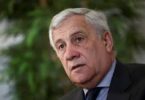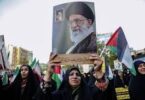Monitoring Desk
WASHINGTON (Reuters): U.S. Senator Joe Manchin, a moderate Democrat, said on Sunday he thought a new White House immigration plan was a good starting point, and criticized House Democratic leader Nancy Pelosi for dismissing it as a way to “make America white again.”
“We don’t need that type of rhetoric on either side, from Nancy, (Republican House Speaker) Paul Ryan or anybody else,” said Manchin, a West Virginian and a leader of a bipartisan Senate group working on immigration. He spoke on CNN’s “State of the Union” program.
Senior White House officials outlined the immigration plan on Thursday that would offer a path to citizenship for up to 1.8 million illegal immigrants brought to the United States as children, a group known as the “Dreamers.”
The proposal also would curb some legal immigration programs and build a border wall with Mexico.
The White House described the “Dreamers” language as a major concession to Democrats, but the plan was quickly dismissed by leading Democrats as a non-starter.
Pelosi said it held Dreamers “hostage to a hateful anti-immigrant scheme” and accused the Trump administration of a campaign “to make America white again.”
In a separate interview Sunday on NBC’s Meet the Press” program, Manchin said he thought the White House plan was “a good starting point.”
His comments highlighted the divisions among Democrats ahead of a Feb. 8 deadline for the U.S. Congress to pass another spending bill and try to reach an immigration agreement that would also protect “Dreamers” from deportation.
Manchin said the bipartisan group led by himself and moderate Republican Senator Susan Collins would meet on Monday evening to examine the White House proposal, adding he expected more details to emerge on Monday.
The group of over 20 senators from both parties, which has been dubbed the “Common Sense Coalition,” helped to end a three-day U.S. government shutdown last week.
“I think we can find a pathway forward (on immigration). I really do,” Manchin told NBC. Manchin announced earlier this week that he will run for re-election this year in a state where Trump trounced Hillary Clinton in 2016.
Explainer: What will be in Trump’s first State of the Union speech?
U.S. President Donald Trump will deliver his first State of the Union address on Tuesday, an hour-long speech to Congress and the nation with the theme: “Building a safe, strong and proud America.”
Trump’s speech comes on the back of a three-day government shutdown, and ahead of a Feb. 8 deadline for deeply divided Republicans and Democrats to agree on how to fund government and overhaul immigration laws.
The address, required by the U.S. Constitution, will focus on Trump’s priorities in five areas, a senior administration official told reporters on Friday: jobs, infrastructure, immigration, trade and national security.
Expect Trump to take a victory lap over his recent tax cuts and record high stock markets. With unemployment for African Americans, Hispanics and women at record lows, Trump will “make clear that all groups are benefiting under this presidency,” the official said.
Trump may talk about some of first lady Melania Trump’s guests for the speech, who are expected to include people who have benefited from the tax cuts.
Trump has pledged to rebuild the nation’s aging infrastructure, but has provided few details on his $1.7 trillion plan.
It is unlikely that he will delve too deeply into the plan during his speech, though the topic which has “large bipartisan support” will be a theme, the official said.
Trump will make the case for letting “Dreamers,” a group of immigrants brought into the country illegally as children, stay in the United States. But he will insist that lawmakers agree to pay for a wall on the southern border, as well as curb immigrants’ ability to sponsor family members.
His immigration proposal has upset both pro-immigration groups who call it a bad trade, and hardliners who object to what they call “amnesty” for illegal immigrants.
Some Democratic lawmakers have invited “Dreamers” as guests to hear the speech in person.
Few issues fire up Trump more than seeing other countries sell more goods to the America than U.S. companies export in return. He will insist in his speech on “fair and reciprocal” trade deals, the official said.
Trump recently told Reuters he would discuss the U.S. trade imbalance with China during his State of the Union speech, and said he was considering retaliation over intellectual property issues.
The White House sought to temper expectations on Friday about how many specifics would be in the address.
The speech will focus on domestic issues, but will include Trump’s plea to beef up funding for the military and a discussion of top threats including North Korea’s nuclear and missile tests.
The White House often struggles to maintain momentum on policy when Trump’s tweets and off-the-cuff remarks upstage his scripted speeches.
Developments in the special counsel probe into Russia’s meddling in the 2016 election also often overshadow his plans.
For example, Trump was praised for his unifying tone in his first address to Congress last February. “Many Americans had not seen the president unfiltered for 60 minutes, and what they saw was a very attractive message and a very attractive agenda,” the official told reporters.
But days after that speech, Trump accused former President Barack Obama on Twitter of ordering his “wires tapped” at Trump Tower in New York City, setting off a firestorm of criticism and drowning out discussion of Trump’s speech.
In an another development, U.S. President Donald Trump would take a “tougher” approach to Brexit negotiations than Britain’s Prime Minister Theresa May, he said in a television interview to be broadcast later on Sunday.
In the interview with British channel ITV, Trump said the European Union was “not cracked up to what it’s supposed to be” and claimed he had predicted the result of the June 2016 referendum in which Britons voted to leave the EU. Trump was elected to the U.S. presidency later the same year.






